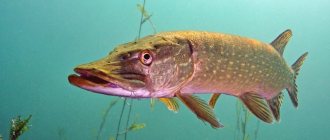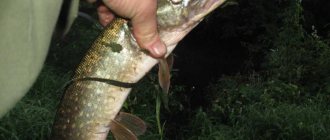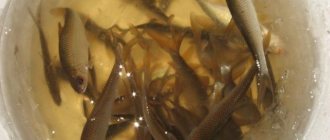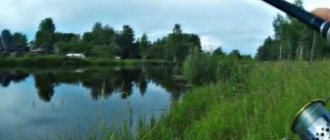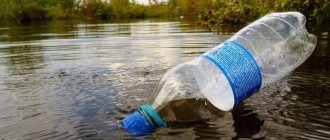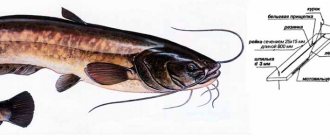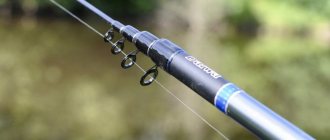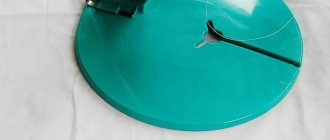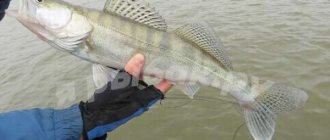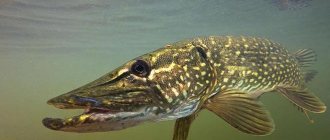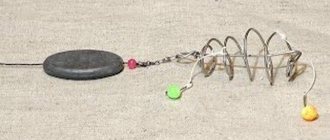Many fishermen are passionate about pike hunting. Fishing with live bait on a donk is an ancient activity, but even today it is very popular and productive. For successful fishing, it is enough to know the basic rules for installing a donkey, as well as their varieties and application depending on external conditions.
Thanks to such fishing with a donka using live bait, you can catch large specimens
The main advantages of casting for pike
Even catching a predator with a simple donka outperforms in many respects compared to modern spinning gear and trolling fishing. Advantages:
- budget price;
- easy to assemble and use (suitable for beginners);
- does not require long casts, which does not affect the result;
- suitable for rivers with intense currents and deep-sea reservoirs;
- you don’t need to constantly watch the tackle (the alarm will let you know about a bite);
- It is permissible to catch pike on a donk both from the shore and from a boat;
- thanks to the sinker, the bait is stably placed at one point and does not move;
- it is possible to install up to 5 equipment simultaneously;
- You can change the bait in 5 minutes.
A significant plus of donks is that older people can use them without any obstacles, since they do not require special efforts and maximum attention. The design of the tackle is such that after casting it, even large fish do not notice it - it does not alert you.
Predator on Predator
How to catch pike on a donk with live bait
Casting a donkey is an important success factor. The elastic band only means throwing the load to the required distance. With this option of equipping the donks, the leashes are installed after casting. In other cases, casting is carried out with live bait suspended on a hook.
A classic donka is folded into rings on the shore of a reservoir and the fisherman, taking the load, swinging it like a pendulum, carefully throws the tackle to the intended point. Rings, equipped with leashes, must be placed one after another into the water. After casting, the main thread is stretched to the limit and tied onto a pre-prepared peg or a suitable bush of vegetation.
Casting a casting hook is similar in technique to casting a feeder rig. After letting the load lie on the bottom and tensioning the cord, install a bite alarm. When biting, do not rush to hook. Pike need time to swallow live bait. Therefore, the first signal indicates a pike attack, a pause of a couple of minutes and a subsequent signal indicate the time to hook the fish.
Fishing is carried out without much haste, allowing the fish, with noticeable stretches, to move away a short distance, and then begin pulling up the tackle again. This method allows you to tire the pike and bring it ashore without candles and jerks. Pike can fall on the bottom of various sizes, and it is advisable for the fisherman to always have a spacious landing net on hand, which, while still in the water, can catch the fish and prevent it from becoming active when approaching the shore, where the fish are especially often frightened by contact with the shoal and changes in illumination , especially vehemently resists playing.
What kinds of donkeys are there for pike?
Varieties, the design of which depends on fishing conditions, traditions in a particular region and the preferences of the fisherman himself. Despite this, they all belong to the varieties described below.
Trophy loot
Donka - installation on a reel
This is a traditional bottom equipment, which includes:
- fishing line with a diameter of about 0.5 mm;
- steel leash;
- hook;
- bait.
Can be held on different reels. With their help, the gear is installed on the ground (it cannot be fished from a boat). So, they first make a base for winding the equipment during pulling and transportation. The end of the line is fixed to the reel, and a weight is attached to the other. A steel leash with a double or tee is attached higher. Before casting, bait is attached.
Donka with a rubber shock absorber - fishing with an elastic band
With a shock-absorbing elastic band
Donka with a shock-absorbing elastic band is common among fishermen. Only it has features: fewer hooks, increased space between the leashes, which are also metal.
The design of the tackle is more complex than that of the supply. There are 2 stoppers placed on the main line at intervals of 1 meter, and a sliding leash in the middle of the stoppers. On one side of the scaffolding, a swivel is knitted, and to it - an elastic band of 7 m and a thickness of 1.5 mm in diameter. Next, attach a 2-meter piece of nylon cord, with a sinker at the end weighing 200 g or more.
When fishing for pike with an elastic band, it is not customary to use a rod with a reel. Before casting, the line is folded in a circle on the ground or other hard surface.
Advantages:
- delivers live bait to the desired point without damage;
- allows you to catch fish using several baits;
- thanks to the rubber band, the prey rarely breaks off and escapes;
- prevents leashes from getting tangled.
Disadvantages of gear:
- designed for fishing for predators where there is no large accumulation of snags, algae and other obstacles;
- problematic in casting and retrieving;
- has limited mobility.
Spinning rod with live bait for fishing from the shore
Spinning donka
This donka with live bait is effective for catching pike. A branch with a thickness of 0.25 to 30 mm and a length of 15 cm with a weight is tied to one end of the main fishing line. The sinker should be small so that if it gets stuck in the bottom pile, the working part of the equipment is not damaged.
At a distance of 10 cm from the sinker, attach a leash with a tee through a carabiner. Usually the length of the leash is 20-25 cm. It is convenient to catch pike with such equipment at a distance of 13-15 m from the coastline, using a swimming device to arrange the equipment. Then you will need to use several gears.
Large pike
Donka with a float - summer fishing
A float rod can be considered another piece of gear - more active, searching. The rod and other components are the same as those of a standard rod. The only difference is that there is a bite alarm and a float. Also different editing.
Float equipment requires the use of moving live bait. It must move independently from side to side, luring the predator and dragging the alarm. The fisherman is also not idle - he periodically throws the fishing rod, moves it and slightly pulls it towards himself. If necessary, you need to change the frozen fish. The main thing is not to lose sight of the float.
Types of float rods
Typically, floats are made of foam in the form of corks, like champagne bottles. A hole is pierced in the middle and a fishing line is threaded through it, which is secured with a ballpoint pen. There are other, more sophisticated designs designed for fishing at depth. To do this, pins are stuck into the side of the cork and fishing line is threaded into their ears. When fishing in shallow water, the rig includes a weight that is attached not to the main line, but to the bottom of the float.
The float twitches slightly, slowly walking along the surface of the water - this is the live bait moving. And since pike mainly take from the bottom, you need to set the appropriate depth. If it suddenly sinks, it means the perch is hooked. When he moves to the side, he caught a pike. In the first case, the hook needs to be done instantly, in the second - not.
How to make a donk for pike with your own hands
You can make a donk for catching pike quite quickly, having prepared the necessary materials in advance. Purchase a skein of strong fishing line or braided cord, it is advisable to buy with a reserve. A hundred-meter coil is ideal. The diameter, as mentioned above, is from 0.3 mm. Pike on a hook are aggressive and strong, and the roughness of the tackle usually doesn’t bother them much; safety margin is a priority .
Reels can be made from plywood or hard and rigid plastic. If you plan to make a donk with an elastic band, then additionally buy a model with a thickness of 0.8-1 mm. On a twenty-meter main cord, it is enough to mount an elastic band 3-4 meters long. The main cord is tied into a loop with an elastic band. At the other end of the elastic band, a carabiner is mounted to secure the load. The weight used is lead and preferably one with flat sides. A pyramid or any flat figure is quite what is needed for a stable position of the load at the bottom.
Important! Weights with rounded shapes are susceptible to the influence of currents and are not recommended for installation for bottom gear.
If you plan to use the donka to install several live baits, then along the cord, after one and a half to two meters, loops are made for mounting the leash. The leashes used are mostly steel. The leash is attached to the loop through a clasp with a swivel. Depending on the method of baiting the bait, select a hook. Fishing practice shows that adjustable doubles are more preferable and most convenient for installation.
Installation of live bait on pike
To collect live bait tackle you will need:
- double, or better yet, triple hook with a leash up to 50 cm;
- sliding weight
- swivel;
- bumper;
- fishing line 40 cm and thickness 0.5 mm.
The use of a sliding sinker increases the receptivity of the equipment and after swallowing the bait the pike does not feel heavy. Only after locking the load with a knot is the predator caught under its own weight.
Donka for live bait
In creeks, channels, whirlpools and small rivers, they resort to a special installation of donkeys - when the distance between the banks allows. They pull a strong cord, to which they attach (from the boat) pieces of monofilament up to 7 meters long with a thickness of 0.4 mm. Metal leashes with hooks and attached bait are tied to their ends. A sinker is attached at a distance of 60-70 cm from the leash. Then they throw the tackle downstream (if there is one) and swim to the shore.
If there are several leashes, the likelihood of catching a trophy pike increases
Choice of live bait
One of the components of successful fishing is the correct selection of bait. It is recommended to get live bait where pike fishing will take place. You can also use purchased options, or fish caught elsewhere. Best bait for pike:
- crucian carp;
- minnows;
- roach;
- perches;
- rudd;
- bream.
Other baits are used depending on the characteristics of the reservoir. So, if there are ruffs or rotan there, then the pike will peck at them.
Rudd - live bait for pike
If you are hunting for a donk, adapted to hook several baits, you can use different types of fish. Then it will be possible to see the gastronomic preferences of the predator and then act in accordance with them.
If there is no bite for a long time, you should examine the tackle and bait. It happens that the bait hides in silt or algae, becoming invisible to the pike. To avoid this, attach a small piece of foam that will keep the bait afloat.
How to properly mount live bait
To prevent the bait from flying off during casting and the current, it is hooked under the dorsal fin, a knot is made from fishing line and the end is tied to a hook. You can catch the fish on the soft tissue of the upper lip.
When fishing for pike with live bait, use crucian carp or perch.
The fish used should be small in size and weigh no more than 100 grams. For trophy pike, you need large bait weighing up to 200 g. The bait is attached at four points near the head, tail and in the central part of the back.
Varieties of donkeys for pike and equipment
Varieties of pike donkey designs can be safely divided into three main groups, on the basis of which each fisherman can bring the tackle to perfection, in his own understanding, and mount it according to his own individual requirements.
The first group includes classic installation, when a weight weighing from 50 to 200 grams is attached to a fishing line or cord up to 20 meters long and with a diameter of 0.3-0.5 mm. Loops are made on the main thread for installation through the swivel of a steel leash. Its length varies from 20 to 40 cm and the leash is equipped with a double or triple hook. The donka is thrown from the shore with baited bait into the water and tied to nearby vegetation or a specially prepared peg. The entire structure, to indicate a bite, is equipped with a bell (read more about how to properly place live bait on a hook).
Equipment of the second type involves the use of an elastic band in the gap between the load and the main thread. Having the ability to stretch 5-7 times, freely increasing its length and returning to its original position, this improvement makes it possible, having cast the tackle, to subsequently re-equip it with live bait without completely removing it from the water. To pull it ashore and lower it back into the forest using the elasticity of an elastic band, in common parlance a model. This type of donkey is called fishing with an elastic band.
The third group includes bottom rigs mounted on a fishing rod with a spinning reel, most often on a conventional spinning rod with a semi-fast action. The equipment is supplied with one live bait, and installation is similar to the previous types: a sinker and a strong metal leash with a hook. The rod is installed on a stand on the shore of a reservoir and, according to the fisherman’s preference, is equipped with a bite alarm. Fishermen nicknamed this design a snooker.
Technique for catching a predator on a donk
The hunting tactics for toothy fish are special. This fish, as soon as it becomes interested, immediately begins to attack. The main thing is not to rush into hooking. It takes time for the fish to thoroughly swallow the bait. When this happens, make a confident sweep with a sweeping movement.
The most difficult thing is to pull the toothy one out. Predatory prey begins to behave aggressively, strongly resisting even on the shore. You have to concentrate extremely hard, because the trophy you come across will begin to rise up in the form of a “candle”, sharply go to the side and jerk its head. We can't let him leave.
River pike
The rod must be kept parallel to the water or tilted lower. If you hunt for pike using a bottom rig from the shore, you need to be extremely focused and careful.
Scheme of donkey action on pike
The subtleties of catching pike on a donk
As it turned out, installing a donkey on a pike with your own hands is very simple. But assembling the tackle is not enough; for successful fishing you need to know where to put the rig and where it will be useless, this is the main subtlety of fishing.
To successfully catch pike in a reservoir, you need to know the bottom topography; it is advisable to install the tackle near:
- deep holes and edges
- at the border with aquatic vegetation
- along thickets of reeds and sedges
- behind snags and trees that have fallen into the water
Correctly mounted live bait will definitely be the key to success; for this, use single hooks, doubles or treble hooks of good quality.
Which place is suitable for catching pike on a donkey from the shore?
Donka is considered a universal tackle, since it can be used both in still water and in strong currents. Differences in bottom height play an important role. It is ideal when, along with the stingrays, there is a border between clean water and overgrown water. Such features indicate that the predator will have somewhere to hide when hunting prey.
Using a donkey requires free space. It is necessary so that when hooked, the pike has the opportunity to move a couple of meters away from this place. To study the depth, it is better to use a special device - an echo sounder or a marker. There is no need to stop in places with dense growth and snags, since the pike with bait can hide in them or the tackle can get tangled.
Pike habitats
The donk needs to be mounted on flat ground, where there are no tall thickets and trees. They can interfere not only with installation, but also with casting.
How to make bottom tackle for a predator with your own hands
Catching pike with live bait is carried out by different types of bottoms, each of which is better demonstrated when working from the shore or from a boat. The design of the gear will be slightly different. Any donk can be assembled with your own hands if you have the necessary elements at your disposal.
Live bait for pike - white fish
An example of assembling a spinning rod:
- Take a spinning rod of the required power and length. Professionals choose steel “Leningradka” or fiberglass “Crocodile”.
- A reel is selected for the fishing rod. If you have the skills to use inertial, then choose this option. Otherwise, they take a cheaper but powerful inertia-free machine with a volume of up to 5000.
- A braid with a diameter of 0.20 mm or monofilament line with a thickness of 0.35 mm is wound onto the spool.
- To the other end of the leka, a rig is attached, including a weight and a hook.
Tackle for catching pike with live bait
It’s not difficult to make a running hook. You will need:
- telescopic form;
- inertia-free, up to 4000 in size and smooth running;
- fishing line with a cross section from 0.35 to 0.5 mm;
- leash with a diameter of at least 0.4 mm;
- single or double hook of the appropriate size;
- lead weight ("olive" type).
All components of bottom tackle are sold in specialized stores.
Making any type of donka is accessible even to a beginner
Having finished manufacturing, they move on to equipment. The main elements used are: fishing line, sinker, hooks with leashes. Hooks - they must be sharp and strong, so it is recommended to stick to foreign brands.
If a feeder with bait is used as a load, various proven methods should be used to secure leashes and hooks (you can connect them up to the feeder or after it). No less popular is the method of arranging hooks in the bait. It is important that they do not cling when casting.
It’s not difficult to remake store tackle in your own way:
- They remove the native bait.
- They put a cambric (a silicone tube for fastening the line to the float) on the line, which is intended for restriction.
- Move on to preparing the leash. Its cross-section should be about 0.25 mm, with a length determined by the type of bait and the intended fish. There can be several leashes. The hook is also selected taking into account the size of the prey.
- Next, install a carabiner with two rings - a swivel. The main line is passed through a hole, the leash is secured to another with a regular fishing knot.
- A colored bead is put on to serve as a soft stopper.
- It will be useful to add a bite alarm.
The feeder version of the donkey (with a feeder) is more suitable for fishing the water area from a swimming device. When installing, they follow a similar algorithm, only adding a container for bait. If loaded modifications are taken, the weight is excluded. Pieces of fish will be used as bait.
How to catch pike perch with live bait
Continuing the topic, we will consider the main and most popular methods of catching pike perch using live baits, describing the configuration of the equipment and the location of installation of the tackle in a body of water being fished for pike perch, and also highlight the most suitable hunting seasons for each method, focusing on the pike perch bite based on its intensity cycles throughout the year .
Fishing with a float rod
A float rod is a universal equipment for catching pike perch with live bait from the shore and from a boat. For the base, select a telescopic Bolognese fishing rod with a length of 4 to 7 meters with a spinning reel. Monofilament fishing line is used as a cord with a fluorocarbon leash up to 40 cm long placed at the end. Sliding weights are used, in the form of an olive. The floats are practical with a barrel-shaped body and a short antenna with the possibility of installing a firefly in its body, which will allow you to comfortably fish with live bait at night. This type of gear is used for fishing at the junctions of shallows and dumps at depths, where fish go out to hunt in the twilight and dark hours of the day. Pike perch are successfully caught using float rigs in the summer months.
Spinning fishing
Pike perch using live bait is effectively caught using a spinning rod remounted under a coastal hook. For the fishing rod, spinning rods of medium and slow action, up to three meters long, are selected. The inertia-free reel is equipped with a braided cord no thicker than 0.2 mm. A sliding flat lead weight is used with an effective mass selected according to the force of the current, and a 0.25 mm fluorocarbon leader completes this simple but effective installation for pike perch. Knit the leash directly to the cord, not forgetting to install a damper bead in front of the knot to prevent deformation of the knot by the sinker when casting the equipment. They fish riverbed pits with baitfish, where pike perch are caught especially well in late autumn, intensively fattening up for the winter season.
Fishing with bottom tackle
Bottom fishing with live bait on lakes is carried out using tackle with an elastic band, which is mounted on the bottom slopes in depth. As the main cord, braided fishing lines from 0.3 mm in diameter are used, equipping them with half-meter leads, in increments of five meters, made of monofilament or fluorocarbon 0.35-0.40 mm thick. The leashes are equipped with fixed foam floats, which should keep live bait 30–40 cm from the bottom. They catch with a rubber band all day long.
Important! If there are no bites, the condition of the live bait is checked every two hours. Read more about catching pike perch on a donka.
Fishing using the presented method is successful in the spring months, still in muddy water. Recently, lovers of pike perch hunting have increasingly begun to use feeder equipment as a bottom fishing rod. The feeder is equipped with a feeder using chicken or beef liver as bait, as well as finely chopped fresh fish, which stimulates more predators to approach the catching point. For installation, sensitive knitting of the inline type is practiced. The feeder shows its prey activity in the summer months, especially in July and August, which is passive in terms of pike perch activity.
Fishing with mugs and girders
The classic live bait tackle for large pike perch is considered to be a circle set with the current over promising sites for pike perch. The mugs are equipped with a 0.25 mm monofilament line without the use of a leash, with an olive weight stopped 40 cm from the hook. Live bait is released 60–100 cm from the bottom. The work of the circles is monitored by a boat moving behind the squadron of fishing devices. The method is effective throughout the open water season.
Stationary zander poles are placed from the shore or from a pole in the water near promising pike-perch points. Equipping a fishing device with a cord, a weight and the method of installing live bait in the water horizon is similar to a floating circle. There is a design for a winter ice trap with a bite alarm in the form of a rising flag. Winter, as well as summer, stationary girders can be successfully used for round-the-clock fishing, monitoring only the activity of the live bait mounted on the hook, which is done at least at three-hour intervals, and monitoring bites.
Useful tips for catching pike with bottom tackle
Favorite habitats
Several practical recommendations for beginners on catching trophy pike on a donk:
- It is advisable to obtain bait near the reservoir where fishing is planned;
- to catch large fish you need larger live bait - weighing more than 150 grams;
- catching period - in early spring, late autumn and in the dead of winter (in summer, the toothy fish does not react so zealously to live bait);
- you need to check the condition of the gear every 2 hours after casting;
- You can’t catch a pike without live bait;
- You can fish for pieces of fish before freeze-up or when using a feeder;
- It is better to place the bait on a treble hook, winding it so that it comes out through the gill opening;
- It is recommended to make the leash yourself (the length should be between 30-50 cm);
- Monk is used as a base;
- Immediately after hooking a fish, you cannot immediately hook it - wait until the bait is completely swallowed.
The remaining subtleties of pike hunting are learned in practice. Fishing for a predator on a donk with live bait is an exciting pastime. If you know how to make tackle and how to catch this hardened prey, a rich catch is guaranteed.
Watch the video: how to catch pike on donkeys using crucian carp as live bait.
Fishing from the shore
To make the gear, you will need a short spinning rod, a small spinning reel, a fishing line 0.4 mm thick, about 40 m long, with a carabiner at the end.
In the process of assembling the donkey, after threading the fishing line through the rings of the rod, you need to tie an insert from the same fishing line 2 meters long to the carabiner. At the end of the insert you need to attach a weight weighing 30 g.
Above the weight, you need to tie 2 leashes through a carabiner (to avoid twisting the main line and leashes).
The first leash, no more than 5 cm long, must be tied at a distance of 15 cm from the weight, the second leash - 15 cm from the first.
There is no need to use the longest wires, because perch is not such a cautious fish. Moreover, this can lead to difficulties with casting. It is better to choose hooks No. 7.
Now the tackle is ready for use.
Worms, leeches and pieces of fish are used for bait.
If there is enough space, then 3 or more such gear can be used to use a donkey for perch from the shore.
The Sazanya Bay Fishing Base has all the conditions for a comfortable stay, interesting fishing and a rich catch. Having come to relax and fish at our base, you will no longer want to look for other places for fishing. We have amazing nature, a comfortable quiet holiday and literally the coolest fishing spots!
